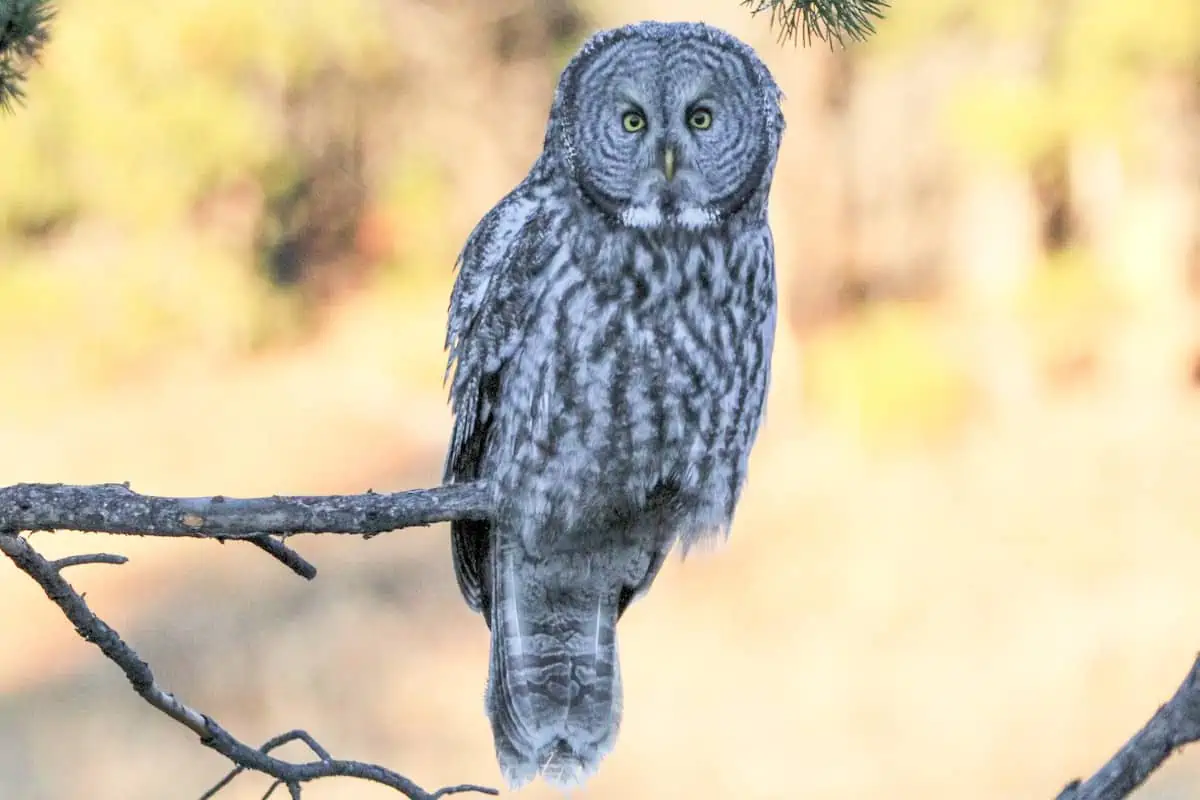Owls are seen with awe by many people. Because of their concealment and nocturnal habits, most of us will never see them. They are all the more fascinating as a result. You might also be curious about how many different owl species may be discovered in the area where I live? We’ll take a look at Wyoming’s 13 owl species in this article.
OWLS IN WYOMING
The barn owl, boreal owl, burrowing owl, eastern screech owl, flammulated owl, great gray Owl, great horned Owl, long-eared Owl, northern Pygmy-owl and northern Saw-whet Owl are among the 13 species of Owls found in Wyoming.
That’s a pretty impressive list! Let’s take a look at each of them.
1. BARN OWL

- Scientific name: Tyto alba
- Length: 12.6 – 15.8 in
- Wingspan: 39.4 – 49.2 in
- Weight: 14.1 – 24.7 oz
The majority of the United States, including Wyoming, is home to barn owls. Grasslands, fields, ranches, agricultural land, and strips of forest are some of their preferred open habitats.
Man-made constructions with a lot of eaves and beams, such as barns, attics, and church steeples, are favorite nesting sites for barn owls. One way they got their name may have been this. Tree holes, caverns, and cliff sides are also used as nests. During the day, Barn Owls are difficult to find since they are quite nocturnal.
They fly low over fields at dusk and through the night, using their exceptional hearing to detect mice and other pests. If you see them in dim light, their huge, ghostly white face and belly can be a disturbing sight!
2. BOREAL OWL
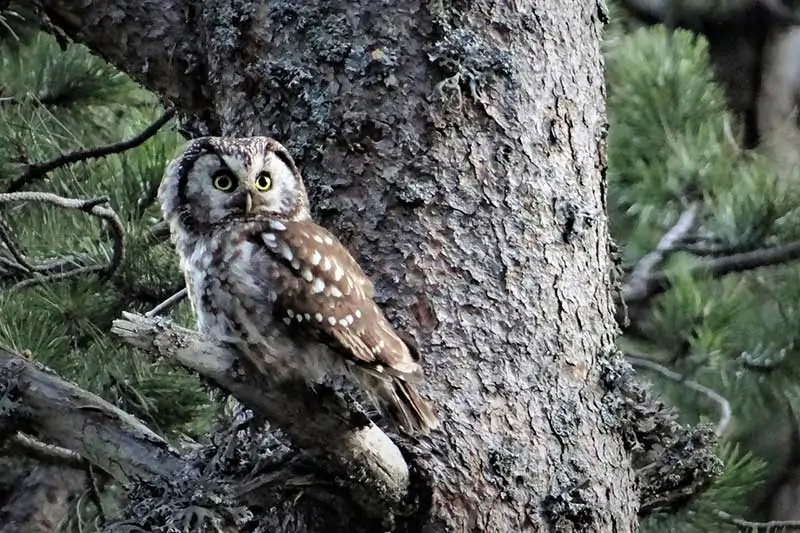
- Scientific name: Aegolius funereus
- Length: 8.3-11.0 in
- Weight: 3.3-7.6 oz
- Wingspan: 21.6-24.4 in
The boreal forest, which stretches from northern North America to Eurasia, is home to Boreal owls, as the name implies. There are only a few states where you can find them, with Wyoming being one of them since the United States is a little too far south for them. Despite the fact that they have only been documented a few times, they are quite uncommon.
Boreal owls, especially throughout the day, are difficult to locate. Each day, they roost in a different tree, so don’t expect to find them in the same one you visited the day before.
They’re tiny owls with enormous, square heads, stocky bodies, and short tails that are about the size of a robin. Before swooping down and grabbing their victim with their talons, they perch and wait for prey like tiny animals and birds to come by.
Boreal owls are generally quiet, and they don’t call much. But, in the late winter and early spring, males call for females more often. Listen for these fast hoots in the evenings to identify them quicker.
3. BURROWING OWL
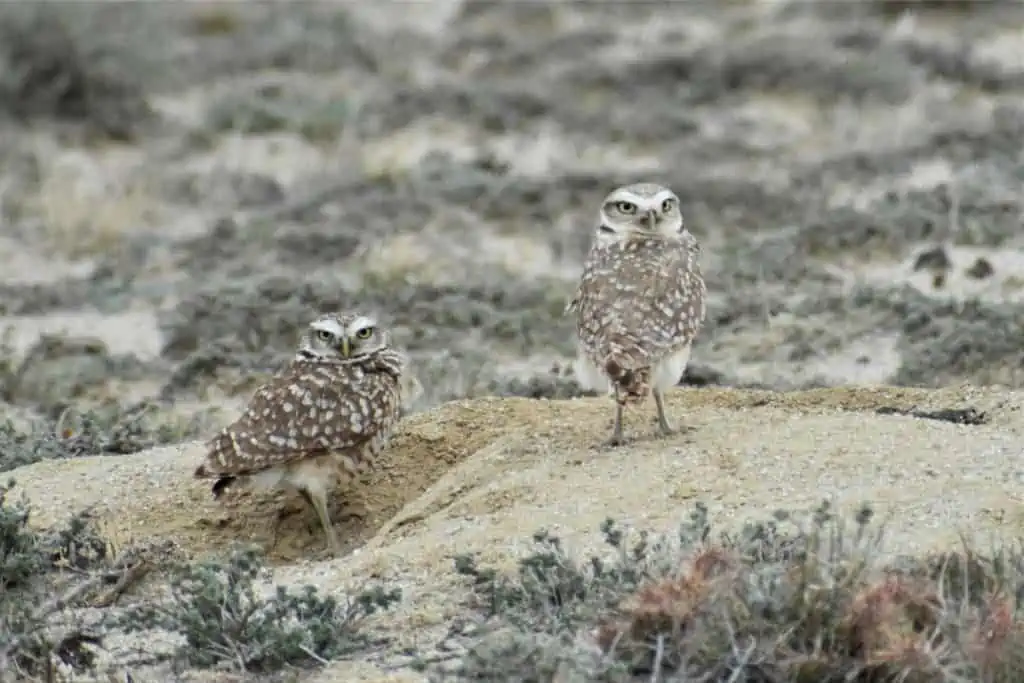
- Scientific name: Athene cunicularia
- Length: 7.5-9.8 in
- Wingspan: 21.6 in
- Weight: 5.3 oz
During the breeding season, Burrowing Owls may be found in Wyoming.
These little owls reside in burrows and have large legs. These burrows are sometimes excavated by them, and occasionally they take over abandoned burrows left by prairie dogs or ground squirrels. Man-made structures, such as pipes, buckets, and culverts have even been discovered to be used for burrows by them.
4. EASTERN SCREECH-OWL

- Scientific name: Megascops asio
- Length: 6.3 – 9.8 in
- Wingspan: 18.9 – 24.0 in
- Weight: 4.3 – 8.6 oz
The eastern screech owl’s range stretches across Wyoming’s eastern half.
Gray, brown, or “red” (really a reddish brown) are the three plumage hues of eastern screech owls. The designs on their feathers, whatever color they may be, help them blend in with tree bark and provide excellent camouflage.
Their name might imply that they create a wailing or screaming noise, but this is not the case. They don’t hoot, instead emitting trilling noises or “whinnies,” which sound like a high-pitched horse.
You may attract eastern screech owls to your yard by setting up an appropriately sized nest box. Farmland, city parks, and suburban neighborhoods are all home to these little owls. Almost any location with trees will do.
5. FLAMMULATED OWL

- Scientific name: Psiloscops flammeolus
- Length: 5.9-6.7 in
- Weight: 1.5-2.2 oz
- Wingspan:15.9-16.1
In far western Wyoming, the flammulated owl has a very small breeding population. These owls are incredibly tiny, and because they spend the majority of their time perched atop huge evergreen trees, they are exceedingly difficult to detect. The most likely method to find them is by hearing. A low, repeated cry is heard from them.
The two places where sightings have been documented are the Jackson area in the northwest and the Medicine Bow National Forest in the south.
During the day, they hunt flying insects like crickets, moths, and beetles. Their diet is primarily insect-based. They look like screech-owls with shorter ear-tufts and have reddish gray feathers that are well-camouflaged.
6. GREAT GRAY OWL

- Scientific name: Strix nebulosa
- Length: 24.0-33.1 in
- Weight: 24.7-60.0 oz
- Wingspan: 53.9-60.2 in
In Alaska and Canada, year-round great gray owls may be found, however they are scarce in the continental United States. While they are still uncommon in the state, Western Wyoming people fall under their distribution.
These huge owls have yellow eyes and a white strip of feathers at the neck that is known as a “bow tie.” Gray owls hunt voles, gophers, chipmunks, and other tiny creatures in meadows and clearings in the dense evergreen foliage of the north. In the United States, Around montane meadows, they prefer pine and fir woodlands.
Gray owls don’t construct their own nests. They might utilize human-made platforms or clumps of mistletoe, as well as an old raven or raptor nest, the top of a shattered tree. Their hearing is acute, and their talons are enormous, allowing them to seize prey beneath hard compacted snow by mere sound.
7. GREAT HORNED OWL

- Scientific name: Bubo virginianus
- Length: 18.1 – 24.8 in
- Wingspan: 39.8 – 57.1 in
- Weight: 32.1 – 88.2 oz
Because of their enormous size, yellow eyes, and “horns” of feathers that protrude on either side of their head, great horned owls are one of the most prevalent and recognized owls in North America. They’re common all year in Wyoming.
Forests, marshes, deserts, and city parks are just a few of the habitats where these owls may be found. Most of them have a cool or warm brown plumage, although their feather color varies.
Mammalian, avian, reptile, insect, and fish are all part of the large horned owl’s diverse diet. Their hoot is a sound that most people associate with owls, and it is frequently employed in television and films.
8. LONG-EARED OWL
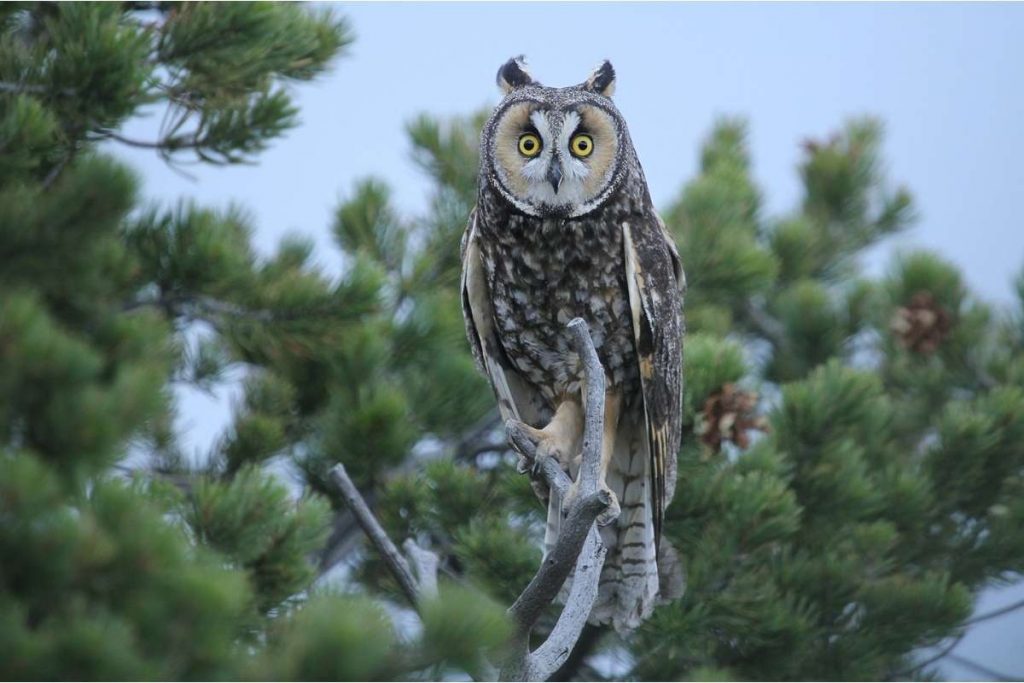
- Scientific name: Asio otus
- Length: 13.8 – 15.8 in (height)
- Wingspan: 35.4 – 39.4 in
- Weight: 7.8 – 15.3 oz
Year-round, Wyoming is home to long-eared owls. Pine stands or woodlands near grassland and pastures are where they prefer to live.
They have a constant startled look with their vivid yellow eyes, white V-shaped facial pattern, oval face disc, and long feather tufts that point straight up. Great horned owls have a face that is rather rounded and white, making them easy to differentiate.
Because of their excellent camouflage and roosting in thicket, they are difficult to locate. On spring and summer evenings, you may hear their long, low hoots.
9. NORTHERN PYGMY-OWL

- Scientific name: Glaucidium gnoma
- Length: 6.4-7.1 in
- Weight: 2.1-2.5 oz
- Wingspan: 14.5–16 in
The mountainous western United States, including Wyoming, is home to the Northern Pygmy-Owl, which is fairly common. They’re active during daylight, which makes them easier to see than most nocturnal owls, yet they’re still rather tiny and perch still waiting for prey — so you’ll need to keep your eyes peeled.
To make finding them easier, try to get acquainted with their high-pitched toots and cries. Songbirds in clusters making a commotion are another good bet. They’ll often approach a Northern Pygmy-Owl and try to frighten it away. Because it regularly eats little song birds, they don’t want this owl around.
The heads of northern pygmy-owls are extremely round, with no ear tufts. Their head and back are brown with white speckles, and their belly has vertical brown stripes.
10. NORTHERN SAW-WHET OWL
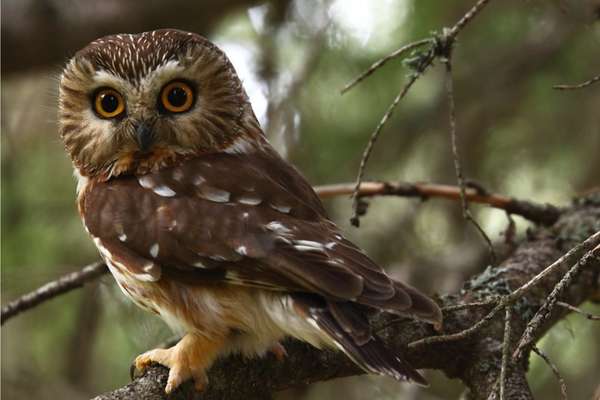
- Scientific name: Aegolius acadicus
- Length: 7.1-8.3 inches
- Weight: 2.3-5.3 oz
- Wingspan: 16.5-18.9 inches
With a round head and yellow eyes, northern saw-whet owls are tiny. These owls are also notoriously difficult to locate for a number of reasons, in addition to their small size.
When they’re perched motionlessly on a branch, their mottled brown plumage blends in very well with the trees around them. Since these owls are only active at night, you won’t encounter them when it is light out. They are also naturally secretive.
When they call the most frequently between January and May, the best bet for locating a northern saw-whet owl is to learn its cry and listen at night. They are known as the “saw-whet” owl because of their unique cry, which sounds like a blade being sharpened on a whetstone. A series of whistled notes with the same pitch make up their too-too-too call.
The prey of these owls are small mammals like mice and voles, and they prefer thick and mature woods. They spend the majority of their time in eastern Wyoming during the winter, but can stay year-round in western Wyoming.
11. SHORT-EARED OWL

- Scientific name: Asio flammeus
- Length: 15 in
- Wingspan: 38 in
- Weight: 12 oz
The summer is nearly entirely spent in Canada and the northern United States by short-eared owls, although they may be found year-round in Wyoming.
They do have “ear tuft” feathers, although they are so short that they are almost never visible. They feature yellow eyes, similar to many owls, but their black irises stand out against their dark irises.
In response to the population of its prey, such as moles, rats, rabbits, and weasels, their populations in a given region might fluctuate from year to year.
They are particularly sensitive to habitat loss and fragmentation from the vast open grasslands they need to be transformed into agricultural land, grazing land, recreational sites, and housing construction.
They are widespread across the globe and may travel across open water for long distances.
12. SNOWY OWL
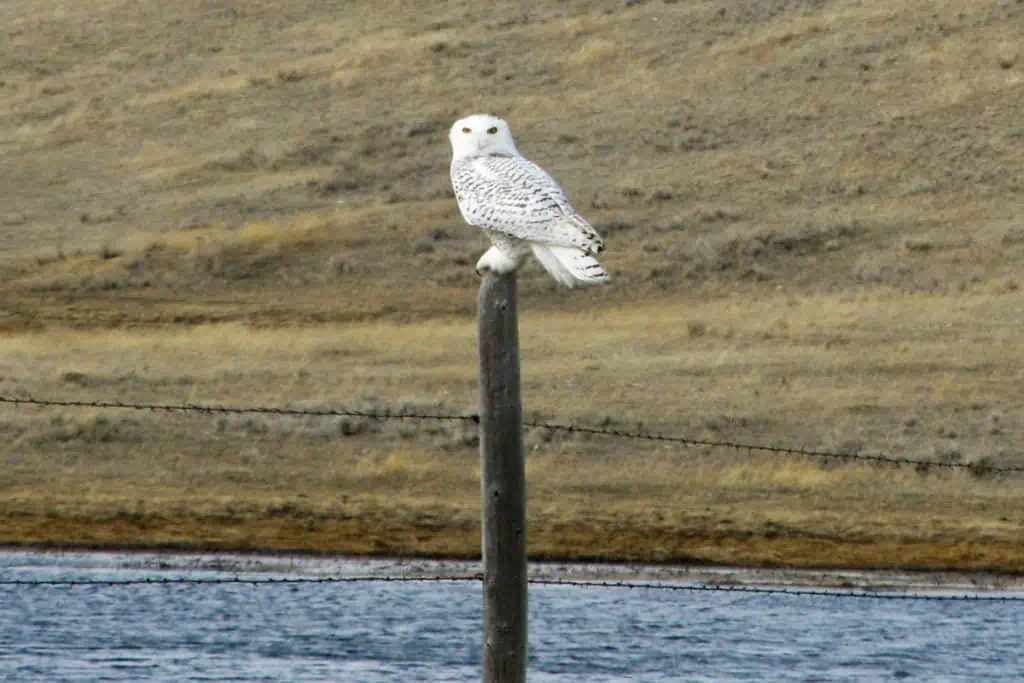
- Scientific name: Bubo scandiacus
- Length: 20.5-27.9 inches
- Weight: 56.4-104.1 oz
- Wingspan: 49.6-57.1 inches
The wintering range of snowy owls extends across much of Canada, but each year they travel farther south into the United States. Sightings have been reported in Wyoming, although this is a uncommon occurrence.
During the summer, these magnificent owls fly north to Canada and Greenland’s arctic areas to breed. All hours of the day, they’ll be hunting lemmings, their favorite summer snack.
Because of their bright white plumage, snowy owls are easier to see than other owls if they are nearby. They are diurnal, unlike most other owls, and are thus active during the day. They like fields, airports, and beaches because they provide them with a lot of space. Look for them on the ground or perched out in the open, especially on snowy days.
As adults, snowy owls are nomads who don’t typically remain in one place for long. Hundreds of miles apart, owls from the same nest that were tracked have been discovered in opposite directions.
13. WESTERN SCREECH OWL

- Scientific name: Megascops kennicottii
- Length: 7.5 – 9.8 in
- Wingspan: 21.6 – 24.4 in
- Weight: 3.5 – 10.8 oz
The western Screech-Owls may be found in numerous states of the western United States, as well as along the west coast of North America. The eastern screech owl favors the east, while the western screech owl favors the west.
The eastern and western types don’t differ visually in any way. They do, however, have distinct hoots. The western screech owl produces a succession of rapid hoots, while the eastern variety produces a descending whinny. Their ranges seldom overlap.
In both rural and urban environments, they nest in tree cavities. Their exceptionally well-camouflaged feathers make them extremely difficult to detect while they’re hiding in tree holes. They’re tiny, stocky-bodied robin-shaped owls with short tails. When they’re roosting in holes during the day, their mostly gray-brown plumage with streaksy undersides blends in exceptionally well against trees.
